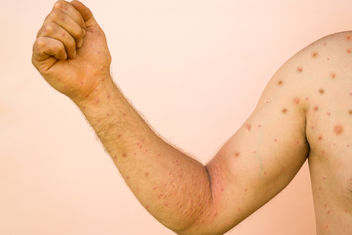What You Need to Know About the Monkeypox Virus
August 17, 2022There has been an ongoing outbreak of the monkeypox virus since May 2022. Many people are still confused about what the monkeypox virus is and what causes it. Learn more about the monkeypox virus, including signs, symptoms and preventative tips.

The Inside Rx Blog
Get the Inside Scoop on tips & tricks that may help your family save on prescriptions!
Subscribe to stay up to date with the latest news and tips
You may have found yourself wondering lately, what is the monkeypox virus? There has been a lot of discussion lately around this rare disease, but many people are still confused on what the monkeypox virus is and what causes it.
The Centers for Disease Control and Prevention (CDC) have been tracking an outbreak of monkeypox which has spread across several countries that don’t normally report monkeypox, including here in the United States. To learn more about monkeypox, including signs and symptoms and preventative tips, read below:
How the monkeypox virus spreads
One of the biggest areas of confusion surrounding this disease is how the monkeypox virus is contracted and what to look out for. The monkeypox virus can be spread in multiple ways such as:
- Through close, personal, skin-to-skin contact, including:
- Direct contact with monkeypox rash, scabs, or body fluids from a person with monkeypox
- Touching objects, fabrics (clothing, bedding, or towels), and surfaces that have been used by someone with monkeypox
- Contact with respiratory secretions
- Intimate contact
A pregnant person can spread the virus to their fetus through the placenta.
It’s also possible for people to contract the monkeypox virus from infected animals, such as being scratched or bitten by the animal. You can also contract the monkeypox virus by coming in contact through preparing, eating, or using products from an infected animal.
Signs and symptoms of monkeypox
Symptoms of the monkeypox virus usually start within 3 weeks of exposure, with the most common symptom being a rash. This rash may be located on or near the genitals (penis, testicles, labia, and vagina) or anus (butthole) but could also be on other areas like the hands, feet, chest, face, or mouth. The rash, which can look like pimples or blisters and may be painful or itchy, will go through several stages, including scabs, before healing.
Symptoms of the monkeypox virus can include: fever, chills, headache, muscle and back aches, swollen lymph nodes, and exhaustion. Respiratory symptoms (e.g. sore throat, nasal congestion, or cough) have also been reported as symptoms of the monkeypox virus. A person with monkeypox can spread it to others from the time symptoms start until the rash has fully healed and a fresh layer of skin has formed. The illness typically lasts 2-4 weeks and you may experience some or all of these symptoms.
While most people who contract the monkeypox virus will get a rash, it is possible to get a rash that is then followed by other symptoms, or to only get a rash without additional symptoms. If someone has flu-like symptoms, they will usually develop a rash 1-4 days later.
Prevention
There are still ways to prevent contracting the monkeypox virus. Healthcare professionals are currently advising the public to take the following steps to prevent getting monkeypox:
- Avoid close, skin-to-skin contact, with people who have a rash that looks like monkeypox.
- Do not kiss, hug, cuddle or have sex with someone with monkeypox.
- Avoid contact with objects and materials that a person with monkeypox has used, such as eating utensils or cups, clothing or bedding, and towels.
- Wash your hands often with soap and water or use an alcohol-based hand sanitizer, especially before eating or touching your face and after you use the bathroom.
Vaccines
In addition to preventative health steps, the CDC also recommends vaccination for people who have been exposed to monkeypox and people who may be more likely to get monkeypox. When properly administered before or after a recent exposure, vaccines can be effective tools at protecting people against monkeypox illness. People who get vaccinated should continue to take steps to protect themselves from infection by avoiding close, skin-to-skin contact, including intimate contact, with someone who has the monkeypox virus. Two vaccines may be used for the prevention of the monkeypox virus infection, JYNNEOS (also known as Imvamune or Imvanex), and ACAM2000.
In the United States, there is currently a limited supply of JYNNEOS, although more is expected in the coming weeks and months. While there is a larger supply of ACAM2000, this vaccine should not be used in people who have certain health conditions, such as a weakened immune system, skin conditions like eczema or other exfoliative skin conditions, or pregnancy. No data are available yet on the effectiveness of these vaccines in the current outbreak.
Click here to read our blog on other required vaccines.
Atenolol
$ 7.66Atorvastatin Calcium
$ 7.84Other Resources
For more information regarding the monkeypox virus, including the latest vaccine updates, case trends, and the 2022 U.S. case count map, please visit the Centers for Disease Control and Prevention website. If you do get sick, Inside Rx is always here to help. Check out our blog for information on other topics. Stay healthy!



